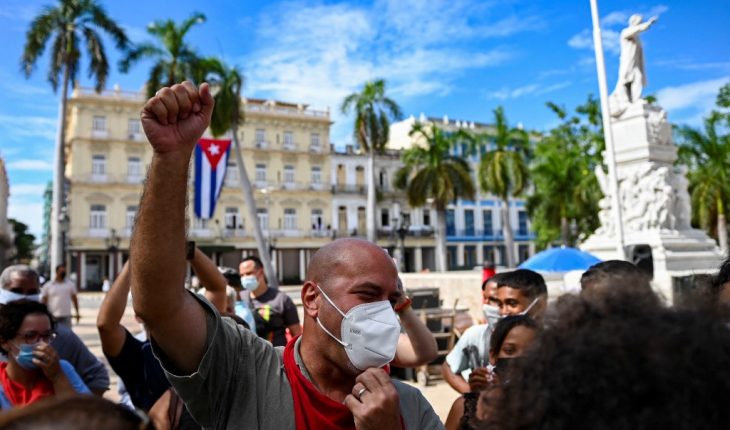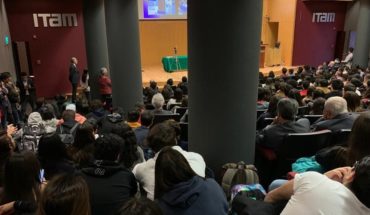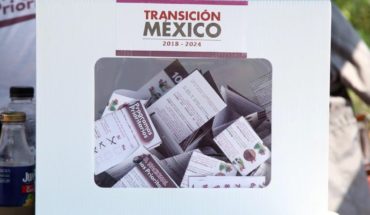This November 15, Cuban citizens will return to the streets to demonstrate against the violence and repressions committed on July 11, when they went out to protest peacefully in the face of the economic crisis, the shortage of medicines and the response to the attention to the COVID-19 pandemic. They will also demand democratic change in Cuba and free expression, say organizers from the island and Cuban community in Mexico.
In Cuba, the peaceful call to this demonstration is called by the Archipelago, a citizen platform in Cuba that was born in the face of the events that occurred on July 11 and seeks to promote a path to democratic transition in that country. So far it has more than 30,000 members who say they are not funded nationally or internationally.
Read: Protests in Cuba: 3 keys to understanding the demonstrations on the island, the largest in decades
As part of this call, the Archipelago platform on Facebook has been dedicated to informing and presenting some of the actions they have planned for this November 14 and 15. In social networks they have #El15NyoMarcho as part of the civic march for change that they are calling.
Dr. Ileana Diéguez Caballero, in an interview for Animal Político, said that it is important to note that the call for this demonstration is born from the Archipelago, a group that is recognized as a uniting space for the wishes of many Cubans made up of more than 30,000 people and that represents the demands of civil society.
For The Archipelago, taking to the streets peacefully means demonstrating against all forms of violence committed by the Cuban State, for the freedom of political prisoners, for their rights, for the construction of a different future for Cuban citizens and for the solution of their differences in a democratic and peaceful manner.
Archipelago has counted 442 cases of convicts and political convicts, so far, of which 228 belong to the “police repression related to #11J.
In an interactive map dedicated to the #15N where the cities that have confirmed their participation in this global action for change appear countries such as Australia, Germany, Brazil, Austria, Belgium, Canada, Costa Rica, Colombia, Chile, Ecuador, United States, Slovakia, Spain, Denmark, France, Honduras, Iceland, Israel, Italy, Mexico, Netherlands, Portugal, Paraguay, United Kingdom, Dominican Republic, Switzerland, Uruguay, among others who have joined the call.
The interactive map #15NCuba was created by the activist Yan Estrada and the Twitter account Cuba Libre from which the cities that are being added prior to the demonstration of this November 15 are constantly updated.
#UltimoMinuto International artists begin to join the campaign of the #15NCuba supporting young Cubans.
SHARE pic.twitter.com/hDgJaiKQ2u
— Cuba_Libre #15NCuba (@Mi_Cuba_Libre) November 13, 2021
At the close of this note, the total number of cities that have confirmed their global participation in the #15NCuba is 120 cities in the world with the presence of the Cuban community, who are organizing to demonstrate in front of Cuban embassies or consulates in their respective countries.
A positioning with poetry
In Mexico, the Cuban community that lives in the country has also joined to demonstrate in a coordinated manner with the call that the Archipelago platform has launched, where cities such as Cancun, Mérida, Querétaro, Hermosillo and Mexico City confirmed their presence to protest in front of representations of the island in spaces such as the Cuban consulate and monuments.
“Our position will be manifested through poetic gestures that have to do with posters that have been elaborated, reading of poems, music. That is the idea, to demonstrate through aesthetic poetic resources to demand the release of all political prisoners in Cuba and demand an end to representation and the impossibility of having rights in Cuba,” he adds.
For Dieguéz Caballero, this demonstration in Mexico means accompanying people who in Cuba cannot demonstrate directly or will be repressed.
Hilda Landrove Torres, a Cuban researcher and cultural promoter, explains that the march of the #15N, in addition to calling for the cessation of the repressive wave of the State in Cuba, is focused on a change that refers to the articulation of a conversation that allows a peaceful transformation of Cuban society.
This, in the face of the response of the Cuban government that considers that Archipielago seeks to “overthrow the government and install liberalism”, mentions the also candidate for Doctor in Mesoamerican Studies by the National University Autonoma from Mexico (UNAM).
“The situation in Cuba, right now, is complicated. It is not possible to know what exactly will happen on 15N but what is certain is that the Cuban community will march as well. It is a proposal that emerged within Cuba,” he adds.
Find out: Protests in Cuba: thousands take to the streets in a massive demonstration to the cry of ‘down with the dictatorship’
“We want to do it because it is something that evokes a gesture that somehow began with this whole process – a year ago – a group of artists associated with the San Isidro Movement began to read poetry in public places and parks in Cuba to ask for the release of a friend who was imprisoned, the rapper Denís Solís, ” Express.
Denis Solis is a Cuban rapper who was arrested in 2020 under Miguel Diaz-Canel, president of Cuba. Currently, the artist is free and assured the media that his detention was arbitrary.
In that sense, Landrove explains that expressing oneself through poetry becomes a cultural tradition that grew and, somehow, jumped into politics because it was based on civil rights, with the intention of having a poetic and artistic look at reality.
A movement for culture and expression
Another of the civic proposals that will be present at the demonstration next #15N in Cuba is Movimiento San Isidro, an initiative composed of artists, activists, journalists, intellectuals and “anyone who feels part of the phenomenon of independence” with an impact on the protection, promotion and defense of civil and cultural rights in protection of Cuban freedom of expression.
According to Movimiento San Isidro, last 2018, the Cuban government proposed Decree 349 which establishes sanctions that penalize freedom of creation, expression, choice of work and dissemination in the field of art and culture, “these being controlled directly by the Ministry of Culture, specifically by the figure of a cultural inspector and constituting a violation of Cultural Rights,” it reads on their website.
In addition to promoting free cultural expression, Movimiento San Isidro also documents the legal status of people who were arbitrarily detained; as a support network among the community within Cuba with the #MSILibre.
For Hilda Landrove, art is also a collective resource that is at hand and that, according to the history of repressions in the Latin American region, corresponds to a way of responding in a peaceful and civic way to the repressions by the State. This has characterized citizen movements with the use of songs, dialogue, solidarity, poetry.
“Cuba is no different from any other country in Latin America, let’s say, yes with the political regime but not with the collective reactions to authoritarianism and repression towards the excesses of the State. They are organized by societies that are increasingly diverse, plural and thinking about peaceful trends and transitions. Archipelago, I think, is part of that tradition,” he adds.
Before a global call outside Cuba, Cuban citizens in Mexico stand in solidarity with the initiative of Cuban citizens from the Archipelago to demonstrate in front of the Embassy of Cuba in Mexico, this November 15 from 2:00 p.m. in Mexico City.
What we do at Animal Político requires professional journalists, teamwork, dialogue with readers and something very important: independence. You can help us keep going. Be part of the team.
Subscribe to Animal Político, receive benefits and support free journalism.#YoSoyAnimal





